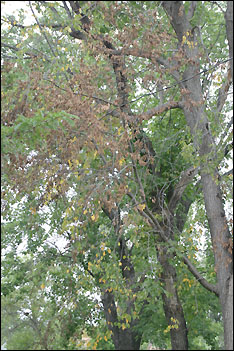Dutch elm disease returns to city
For the past several weeks, city crews have been busy identifying infected trees. Early detection and removal of infected trees is the key to stopping the spread of the disease, said Mergen.
Since treating Dutch elm disease is cost prohibitive, the city hopes to eliminate the diseased trees before beetles can spread the disease.
Injecting fungicides to kill the disease is expensive and unpredictable, according to Carl Hoffman, a horticulturist for the Stearns County Extension Office. The only reliable method for getting rid of the disease is to remove diseased trees before the disease has a chance to spread. Just cutting down the trees is not enough, Hoffman added. It's important to destroy the bark on the downed trees, otherwise the beetles can continue to carry the fungus from the logs to healthy trees. Chipping the tree or debarking it before using the logs as firewood are good ways to destroy the fungus, according to Hoffman.
 According to city ordinance, once a tree has been identified as having Dutch elm disease, the property owner has 20 days to have the tree removed, said Mergen. If the tree isn't removed within the allotted time, the city will cut it down and bill the property owner for the removal costs, he added.
According to city ordinance, once a tree has been identified as having Dutch elm disease, the property owner has 20 days to have the tree removed, said Mergen. If the tree isn't removed within the allotted time, the city will cut it down and bill the property owner for the removal costs, he added.
Dutch elm disease has been discovered again this summer by the city. Twenty trees in the city have been ordered to be cut in an effort to prevent the spread of the disease, which kills American elm trees.
Unfortunately, removing trees, especially those near houses or other structures can be expensive, between $500 and $700, said Mergen.
Dutch elm disease is a fungal disease infecting the American elm tree. It clogs the elm tree's circulation system - the xylem and phloem, in the soft layer just below the bark - making it impossible for the tree to circulate water and nutrients. As a result, branches wither and die. As the disease progresses, whole trees succumb to the disease.
Trees infected with the disease can be identified by the yellowing and the wilting of the leaves. At first the signs may appear on just one or two branches, but it will spread throughout the tree.
Because it can be difficult to identify diseased trees in the fall, suspect trees should be checked for discoloration in the outer sapwood, another sign of infection. Mergen or most landscape professionals can do this check.
The fungus that causes Dutch elm disease is carried by a normally harmless beetle that lives just under the bark and eats the sap from elm trees. When the beetle moves from an infected tree to a healthy one, it carries disease spores with it.
Insecticides are not effective against the disease because just killing the beetles does not stop the disease itself. It may temporarily stop the spread of the disease, but insecticides will not stop the disease. Repeated applications would be needed to keep beetles away from the infected tree and to keep them from spreading the disease.
The disease can also be spread by root grafting of elm trees that stand near each other.
Homeowners can help protect their elm trees from infection by avoiding pruning during the warm summer months when insects are active, said Hoffman. The beetles that spread Dutch elm disease are attracted to new injuries in trees. While it is virtually impossible to protect the trees from all injuries, such as wind damage, waiting until fall to prune elm trees can be an effective way of protecting the trees, said Hoffman.
Dutch elm disease entered the United States from Europe in the 1960s, said Hoffman. In the 1980s and 1990s, a concentrated effort was made throughout the state to eradicate the disease but that effort dropped off as many of Minnesota's American elm trees were destroyed, he added.
In Paynesville, Dutch elm disease appeared in the 1970s, when elm trees comprised a majority of the trees within the city limits. Several hundred elm trees, including many of the ones that once lined Elm Street, were destroyed. In the late 1970s, some 300 elm trees were cut after their infection by Dutch elm disease. More recently, 80 elm trees were cut within the city in 1991. The disease didn't re-emerge this year, said Hoffman. It never went away; it just went unnoticed. Diligence will be required to keep the disease under control, he said.
Scientists have been very successful at breeding Dutch elm resistant trees in the past decade, so those who love elm trees may want to check into replacing lost trees with the new, disease-resistant elms, added Hoffman.
Contact the author at editor@paynesvillepress.com • Return to News Menu
Home | Marketplace | Community